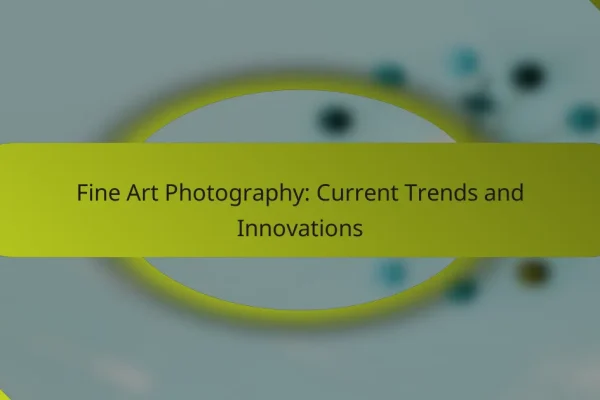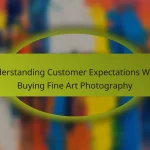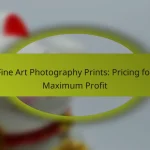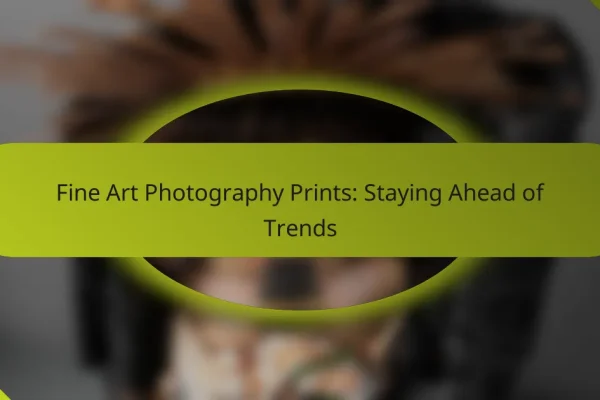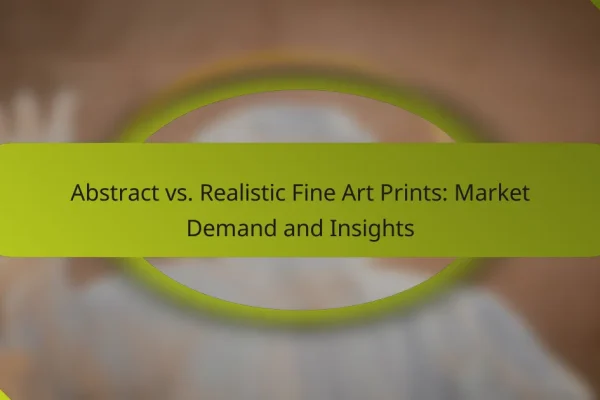What are the current trends in fine art photography prints?
The current trends in fine art photography prints reflect a shift towards exclusivity, sustainability, and innovation. Artists and collectors are increasingly valuing limited editions, eco-friendly practices, and the blending of digital and traditional techniques.
Increased demand for limited editions
Limited edition prints are gaining popularity as collectors seek unique pieces that hold value over time. These prints are often produced in small quantities, which enhances their exclusivity and appeal.
Artists typically number and sign these editions, providing authenticity and a sense of ownership for buyers. Prices for limited editions can vary widely, often ranging from a few hundred to several thousand dollars, depending on the artist’s reputation and the print’s size.
Rise of sustainable printing practices
Sustainability is becoming a key consideration in the fine art photography print market. Many artists are opting for eco-friendly materials and processes, such as using recycled paper and non-toxic inks.
These practices not only reduce environmental impact but also resonate with a growing audience that values sustainability. Artists can often charge a premium for prints that are marketed as environmentally friendly, appealing to conscious consumers.
Popularity of large-format prints
Large-format prints are increasingly sought after for their visual impact and ability to transform spaces. These prints can range from 24 inches to several feet in width, making them ideal for galleries and private collections alike.
Collectors appreciate the dramatic presence of large prints, which can serve as focal points in a room. However, artists should consider the costs associated with producing and shipping larger works, as these can be significantly higher than standard sizes.
Integration of digital art with traditional photography
The fusion of digital art with traditional photography is reshaping the fine art landscape. Artists are experimenting with digital manipulation techniques, creating hybrid works that blend photography with graphic design elements.
This trend allows for greater creativity and innovation, attracting a diverse audience. Collectors are increasingly interested in these mixed-media pieces, which can offer a fresh perspective on conventional photography.
How to choose fine art photography prints?
Choosing fine art photography prints involves considering the artist’s reputation, evaluating print quality and materials, and assessing the emotional impact of the artwork. These factors will help ensure that your selection aligns with your aesthetic preferences and investment goals.
Consider the artist’s reputation
The reputation of the artist plays a significant role in the value and desirability of fine art photography prints. Established artists with a strong portfolio and recognition in the art community often command higher prices and are more likely to appreciate in value over time.
Research the artist’s background, exhibitions, and previous sales to gauge their standing in the art world. Look for artists who have received awards or have been featured in reputable galleries, as this can indicate their credibility and the quality of their work.
Evaluate print quality and materials
Print quality is crucial when selecting fine art photography prints. Look for prints made using high-quality materials such as archival paper and ink, which can enhance longevity and visual appeal. Prints produced using giclée techniques are often preferred for their vibrant colors and fine detail.
Additionally, consider the size and framing options available. Larger prints can make a bold statement, while smaller pieces may fit better in certain spaces. Ensure that the materials used for framing are also of high quality to protect the artwork over time.
Assess the artwork’s emotional impact
The emotional impact of a fine art photography print is essential to consider, as it should resonate with you personally. Choose pieces that evoke feelings or memories, as this connection can enhance your enjoyment and appreciation of the artwork.
Think about how the artwork will fit into your living or working space. Does it complement your existing decor? Does it inspire conversation? Selecting a piece that aligns with your emotional response will make it a more meaningful addition to your collection.
What are the best platforms for purchasing fine art photography prints?
The best platforms for purchasing fine art photography prints include Saatchi Art, Artfinder, and Society6. Each offers unique features that cater to different preferences, making it easier to find the perfect piece for your collection.
Saatchi Art for diverse selections
Saatchi Art is known for its extensive collection of fine art photography prints from artists around the globe. The platform allows you to browse by style, subject, or medium, providing a wide range of options to suit various tastes and budgets.
When purchasing from Saatchi Art, consider the artist’s background and the print’s provenance. Prices can vary significantly, often starting from a few hundred dollars to several thousand, depending on the artist’s reputation and the print’s exclusivity.
Artfinder for unique pieces
Artfinder specializes in original artwork and limited edition prints, making it an excellent choice for those seeking unique fine art photography. Each piece is sold directly by the artist, which often means you can find one-of-a-kind works that aren’t available elsewhere.
While browsing Artfinder, pay attention to the artist’s profile and customer reviews. Prices typically range from around $50 to several hundred dollars, depending on the artist and the print’s rarity.
Society6 for customizable options
Society6 offers a platform where artists can upload their photography, which can then be printed on various products, including art prints, wall tapestries, and home decor items. This allows for a high degree of customization, as you can choose different sizes and formats for your prints.
When using Society6, keep in mind that the quality can vary based on the artist and the product type. Prices generally start at around $20 for smaller prints, making it an affordable option for those looking to decorate their space with art.
What factors influence pricing of fine art photography prints?
The pricing of fine art photography prints is influenced by several key factors, including the artist’s reputation, the size and materials of the print, and the current market demand. Understanding these elements can help collectors and buyers make informed decisions when purchasing art.
Artist’s experience and recognition
The artist’s experience and recognition play a significant role in determining the price of their photography prints. Established artists with a strong portfolio and previous exhibitions typically command higher prices than emerging photographers. Collectors often seek works from artists who have received awards or critical acclaim, as this can indicate quality and desirability.
For example, prints from a well-known artist can range from hundreds to thousands of dollars, while works from lesser-known photographers may be priced in the low hundreds. Buyers should consider the artist’s track record and market presence when evaluating a print’s value.
Print size and materials used
The size and materials of a fine art photography print significantly impact its pricing. Larger prints generally cost more due to the increased material and production costs. Additionally, the choice of printing medium—such as archival paper, canvas, or metal—can also affect the price, with higher-quality materials typically leading to higher costs.
For instance, a small print on standard paper might be priced at around $100, while a large canvas print could reach several thousand dollars. Buyers should assess the quality of materials used and the overall presentation of the print when considering its price.
Market demand and rarity
Market demand and rarity are crucial factors in the pricing of fine art photography prints. Limited editions or unique prints often fetch higher prices due to their scarcity. When demand for a particular artist or style increases, prices can rise significantly, reflecting the market’s interest.
For example, a limited edition print of 50 copies might sell for a premium compared to an open edition print. Buyers should research current trends and sales to gauge the demand for specific artists or styles, helping them make better purchasing decisions.
How to display fine art photography prints effectively?
To display fine art photography prints effectively, focus on proper framing, suitable lighting, and matching the decor style. These elements enhance the visual impact and longevity of the artwork while ensuring it complements the surrounding environment.
Use proper framing techniques
Choosing the right frame is crucial for showcasing fine art photography. Consider using acid-free mats and UV-protective glass to prevent damage from light exposure. A well-chosen frame can enhance the aesthetic appeal and draw attention to the artwork.
When selecting a frame, think about the size and style. A frame that is too large or too small can detract from the piece. Aim for a balance where the frame complements the artwork without overwhelming it.
Consider lighting conditions
Lighting plays a vital role in how fine art photography prints are perceived. Natural light is often the best option, but it can fade colors over time. If using artificial lighting, opt for LED lights with a color temperature of around 3000K to 4000K, as they provide a warm glow without damaging the artwork.
Position lights at an angle to reduce glare and highlight the details of the print. Avoid direct overhead lighting, which can create harsh shadows and diminish the viewing experience.
Match decor style with artwork
Aligning the decor style with the fine art photography prints creates a cohesive look in your space. For instance, modern prints may look best in minimalist frames, while vintage photographs might benefit from ornate framing styles. Consider the colors and themes of both the artwork and the surrounding decor.
Take into account the overall ambiance of the room. A contemporary piece might clash in a traditional setting, so ensure that the artwork enhances the existing decor rather than competing with it. This harmony will elevate the overall aesthetic of the space.
What are the benefits of investing in fine art photography prints?
Investing in fine art photography prints offers both aesthetic enjoyment and potential financial appreciation. These prints can enhance your living space while also serving as a tangible asset that may increase in value over time.
Enhancing your living space
Fine art photography prints can transform the ambiance of any room, adding character and sophistication. Selecting pieces that resonate with your personal style can create a more inviting and inspiring environment.
Consider the size and color palette of the prints to ensure they complement your existing decor. Large, bold images can serve as focal points, while smaller prints can be grouped for a cohesive gallery wall effect.
Potential for financial appreciation
Investing in fine art photography can yield financial returns, especially if you choose works by emerging or established artists. The value of these prints can appreciate over time, making them not just decorative items but also investment opportunities.
Research market trends and artist reputations to make informed decisions. Look for limited editions or signed prints, as these often hold higher value in the art market.
Supporting artists and the art community
Purchasing fine art photography prints directly supports artists and their creative endeavors. This investment fosters a vibrant art community and encourages artists to continue producing innovative work.
Engaging with local galleries or art fairs can provide opportunities to discover new talent and support your local art scene. Consider attending exhibitions to connect with artists and learn more about their work.
